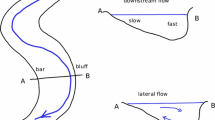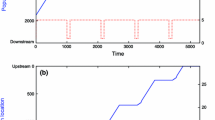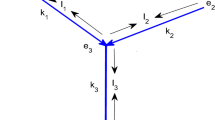Abstract
The question how aquatic populations persist in rivers when individuals are constantly lost due to downstream drift has been termed the “drift paradox.” Recent modeling approaches have revealed diffusion-mediated persistence as a solution. We study logistically growing populations with and without a benthic stage and consider spatially varying growth rates. We use idealized hydrodynamic equations to link river cross-sectional area to flow speed and assume heterogeneity in the form of alternating patches, i.e., piecewise constant conditions. We derive implicit formulae for the persistence boundary and for the dispersion relation of the wave speed. We explicitly discuss the influence of flow speed, cross-sectional area and benthic stage on both persistence and upstream invasion speed.
Similar content being viewed by others
References
Allan, J., 1995. Stream Ecology: Structure and Function of Running Waters. Chapman & Hall, London.
Aronson, D., 1983. The role of diffusion in mathematical population biology: Skellam revisited. In: Levin, S. (Ed.), Mathematics in Biology and Medicine, Lecture Notes on Biomathematics, vol. 57. Springer-Verlag, Berlin, pp. 2–6.
Aronson, D., Weinberger, H.F., 1975. Nonlinear diffusion in population genetics, combustion, and nerve pulse propagation. In: Goldstein, J. (Ed.), Partial Differential Equations and Related Topics, Lecture Notes in Mathematics, vol. 446. Springer-Verlag, Berlin, pp. 5–49.
Baker, R., Dunn, P., 1990. New Directions in Biological Control. Alan Liss, New York.
Ballyk, M., Smith, H., 1999. A model of microbial growth in a plug flow reactor with wall attachment. Math. Biosci. 158, 95–126.
Ballyk, M., Dung, L., Jones, D.A., Smith, H., 1998. Effects of random motility on microbial growth and competition in a flow reactor. SIAM J. Appl. Math. 59(2), 573–596.
Bencala, K., Walters, R., 1983. Simulation of solute transport in a mountain pool-and-riffle stream: A transient storage model. Water Resources Res. 19(3), 718–724.
Berestycki, H., Hamel, F., Roques, L., 2005. Analysis of the periodically fragmented environment model: Species persistence. J. Math. Biol. 51, 75–113.
Botsford, L.W., Hastings, A., Gaines, S.D., 2001. Dependence of sustainability on the configuration of marine reserves and larval dispersal distance. Ecol. Lett. 4, 144–150.
Cantrell, R., Cosner, C., 1991. Diffusive logistic equations with indefinite weights: Population models in disrupted environments. II. SIAM J. Math. Anal. 22, 1043–1064.
Cantrell, R.S., Cosner, C., 1993. Should a park be an island? SIAM Appl. Math. 53, 219–252.
Cantrell, R.S., Cosner, C., 2001. Spatial heterogeneity and critical patch size: Area effects via diffusion in closed environments. J. Theor. Biol. 209, 161–171.
Cantrell, R.S., Cosner, C., 2003. Spatial Ecology via Reaction—Diffusion Equations. Mathematical and Computational Biology. Wiley, New York.
Cruywagen, G., Kareiva, P., Lewis, M., Murray, J., 1996. Competition in a spatially heterogeneous environment: Modelling the risk of spread of a genetically engineered population. Theor. Popul. Biol. 49(1), 1–38.
DeAngelis, D., Loreau, M., Neergaard, D., Mulholland, P., Marzolf, E., 1995. Modelling nutrient-periphyton dynamics in streams: The importance of transient storage zones. Ecol. Model. 80, 149–160.
Dent, C., Henry, J., 1999. Modelling nutrient-periphyton dynamics in streams with surface—subsurface exchange. Ecol. Model. 122, 97–116.
Eagleson, P., 1970. Dynamic Hydrology. McGraw-Hill, New York.
Einstein, A., 1906. Zur Theorie der Brownschen Bewegung. Ann. Phys. 19, 371–381.
Fisher, R., 1937. The advance of advantageous genes. Ann. Eugenics 7, 355–369.
Gaylord, B., Gaines, S., 2000. Temperature or transport? Range limits in marine species mediated solely by flow. Am. Nat. 155, 769–789.
Giller, P., 2005. River restoration: seeking ecological standards. J. Appl. Ecol. 42, 201–207.
Hadeler, K., 1999. Reaction transport systems in biological modelling. In: Capasso, V., Diekmann, O. (Eds.), Mathematics Inspired by Biology, Lecture Notes Mathematics, vol. 1714. Springer-Verlag, Heidelberg, pp. 95–150.
Hadeler, K., Lewis, M., 2002. Spatial dynamics of the diffusive logistic equation with sedentary component. Can. Appl. Math. Quart. 10, 473–500.
Hastings, A., Cuddington, K., Davies, K., Dugaw, C., Elmendorf, A., Freestone, A., Harrison, S., Holland, M., Lambrinos, J., Malvadkar, U., Melbourne, B., Moore, K., Taylor, C., Thomson, D., 2005. The spatial spread of invasions: new developments in theory and evidence. Ecol. Lett. 8, 91–101.
Hill, B., Herlihy, A., Kaufmann, P., Stevenson, R., McCormick, F., 2000. Use of periphyton assemblage data as an index of biotic integrity. J. North Am. Benthol. Soc. 19(1), 50–67.
Huisman, J., Arrayás, M., Ebert, U., Sommeijer, B., 2002. How do sinking phytoplankton species manage to persist. Am. Nat. 159, 245–254.
Kierstead, H., Slobodkin, L.B., 1953. The size of water masses containing plankton blooms. J. Marine Res. 12, 141–147.
Kolmogorov, A., Petrovskii, I., Piskunov, N., 1937. A study of the equation of diffusion with increase in the quantity of matter, and its application to a biological problem. Bjol. Moskovskovo Gos. Univ. 17, 1–72.
Kot, M., Schaffer, W.M., 1986. Discrete-time growth-dispersal models. Math. Biosci. 80, 109–136.
Lewis, M., Schmitz, G., 1996. Biological invasion of an organism with separate mobile and stationary states: Modeling and analysis. Forma 11, 1–25.
Lewis, M., Schmitz, G., Kareiva, P., Trevors, J., 1996. Models to examine containment and spread of gentically engineered microbes. Mol. Ecol. 5, 165–175.
Logan, J., 2001. Transport Modeling in Hydrogeochemical Systems. Interdisciplinary Applied Mathematics. Springer, New York.
Lutscher, F., Pachepsky, E., Lewis, M., 2005. The effect of dispersal patterns on stream populations. SIAM Appl. Math. 65(4), 1305–1327.
Lutscher, F., McCauley, E., Lewis, M. Spatial patterns and coexistence mechanisms in rivers. Theor. Pop. Biol., submitted for publication.
Magnus, W., Winkler, S., 1979. Hill’s Equation. Dover, New York.
Medlock, J., Kot, M., 2003. Spreading diseases: Integro-differential equations new and old. Math. Biosci. 184, 201–222.
Mulholland, P., DeAngelis, D., 2000. Surface–subsurface exchange and nutrient spiraling. In: Jones, J., Jr., Mulholland, P. (Eds.), Streams and Ground Waters. Academic Press, New York, pp. 149–166.
Müller, K., 1954. Investigations on the organic drift in north Swedish streams. Technical Report 34, Institute of Freshwater Research, Drottningholm.
Müller, K., 1982. The colonization cycle of freshwater insects. Oecologica 53, 202–207.
Murray, J., Sperb, R., 1983. Minimum domains for spatial patterns in a class of reation diffusion equations. J. Math. Biol. 18, 169–184.
Othmer, H., 1983. A continuum model for coupled cells. J. Math. Biol. 17, 351–369.
Pachepsky, E., Lutscher, F., Nisbet, R., Lewis, M.A., 2005. Persistence, spread and the drift paradox. Theor. Popul. Biol. 67, 61–73.
Potapov, A., Lewis, M., 2004. Climate and competition: The effect of moving range boundaries on habitat invasibility. Bull. Math. Biol. 66(5), 975–1008.
Robbins, T.C., Lewis, M.A. Modeling population spread in heterogeneous environments using integrodifference equations. SIAM J. Appl. Math., submitted for publication.
Sherratt, J., 2005. An analysis of vegetation stripe formation in semi-arid landscapes. J. Math. Biol. 51, 183–197.
Shigesada, N., Kawasaki, K., Teramoto, E., 1986. Traveling periodic waves in heterogeneous environments. Theor. Popul. Biol. 30, 143–160.
Skellam, J.G., 1951. Random dispersal in theoretical populations. Biometrika 38, 196–218.
Speirs, D., Gurney, W., 2001. Population persistence in rivers and estuaries. Ecology 82(5), 1219–1237.
Turchin, P., 1998. Quantitative Analysis of Movement. Sinauer Assoc., Sunderland, MS.
Van Kirk, R.W., Lewis, M.A., 1997. Integrodifference models for persistence in fragmented habitats. Bull. Math. Biol. 59(1), 107–137.
Van Kirk, R.W., Lewis, M.A., 1999. Edge permeability and population persistence in isolated habitat patches. Nat. Resource Model. 12, 37–64.
Weinberger, H.F., 1982. Long-time behavior of a class of biological models. SIAM J. Math. Anal. 13, 353–396.
Weinberger, H.F., 2002. On spreading speeds and traveling waves for growth and migration models in a periodic habitat. J. Math. Biol. 45, 511–548.
Xin, J., 2000. Front propagaion in heterogeneous media. SIAM Rev. 42(2), 161–230.
Author information
Authors and Affiliations
Corresponding author
Rights and permissions
About this article
Cite this article
Lutscher, F., Lewis, M.A. & McCauley, E. Effects of Heterogeneity on Spread and Persistence in Rivers. Bull. Math. Biol. 68, 2129–2160 (2006). https://doi.org/10.1007/s11538-006-9100-1
Received:
Accepted:
Published:
Issue Date:
DOI: https://doi.org/10.1007/s11538-006-9100-1




